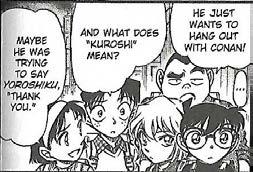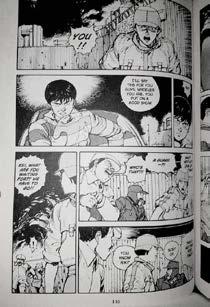
8 minute read
Anime and Manga Translations: The Fall of Localization
Adriana Garcia (Sapporo Alumnus)
If you’ve been following the anime and manga scene in your home country, you’ve most likely noticed the increase in both quality and quantity of Japanese titl es in bookstores, online libraries, DVD sections, and even streaming services. Both legal and illegal translations have developed throughout the years due to the proliferation of the internet, which allows opinions and feedback to be shared, as well as the growing ability of fans to understand the original Japanese sources. Such changes include decreased localization—the adaptation of settings and people to fit where the audience is from rather than keeping it Japanese—as well as the speed of release dates and reduced translation times.
Advertisement
Early anime translations have become dated, largely due to the rampant nature of localization. Character’s names were often changed completely in order to appeal to English speaking audiences. Even our dear “Tetsuwan Atomu” was not immune to this localization treatment and is still known today as “Astro Boy”. If you know the story of “Astro Boy”, you would know that Astro was built by Dr. Boynton to replace his late son, Toby. That is to say, Atomu was built by Dr. Tenma to replace his late s on, Tobio. These names were mixed together in the 2009 “Astro Boy” CGI film (which was surprisingly good!) starring Nicolas Cage as Dr. Tenma, and his son being called both “Toby Tenma” and “Astro”.
My personal favorite example of localization would be in “Mahha Go Go Go”, where names were given based on personality. Goh was a race car driver, so he was given the name “Speed.” His little brother Kurio was hyper and chipper like a sprite, so he was given the name “Spritle.” His girlfriend was cunning and a bit of a trickster, and so she was named “Trixie.” His parents were stuck with the names “Pops” and “Moms,” but due to the family nature of this race team, they were given the last name “Racer.” And just like that the series “Speed Racer” was born, a name that stuck with the 2007 Japanese-dubbed live-action movie as well.
“Battle of the Planets,” the American localization of the Japanese 1972 anime series “Gatchaman,” is listed among one of the greatest victims of this localization process, with a translation never really being made at all. It can be argued that this had been done for several early anime, but this one stands out the most because the localized plot of “Battle of the Planets” was made up by watching what happened; words were added to fit the scene rather than in any attempt to translate, and death scenes were removed to make the show more child-friendly.
By the 1990s translation attempts had improved. There were still name changes in “Sailor Moon” but not in “Dragon Ball Z.” At this time, anime wasn’t just something on TV anymore. It was something being sold on VHS and being rented in video stores across Western countries.
Manga was also not immune to the aforementioned localization system. If the manga was based on an anime that was already localized, then an effort was made to match the name changes. “Case Closed” is particularly notable due to two different companies releasing the anime and manga resulting in some characters ending up with two different English names. Nowadays this practice has ceased; new characters have their original Japanese name while pre-existing characters have the localized version (thank goodness the protagonist “Conan” remained as “Conan”).

A more recent translation of "Case Closed" explains some Japanese, rather than localizing it out entirely.
Another big factor in manga publication is the fact that English is not read the same way as Japanese (left-to-right, as opposed to rightto-left). Last Christmas, my cousin asked me why the manga she bought her son was backwards and the simple explanation was that it was kept the same way it was published in Japanese—with the right-to-left style. Tokyopop, an American distributor, licensor, and publisher of anime and manga, can be credited for popularizing the authentic right-to-left manga format, which halted the previous trend of mirroring manga pages to match the English left-to-right reading style. Mirroring meant that most of the characters became left-handed, anime visuals may not match the manga adaptations because manga panels were literally backwards, and if any Japanese words were left in the background they were also mirrored (my favorite example of this tendency to flip background text occurred in “Ranma 1/2,” where it actually wasn’t even Japanese text that was flipped, but an English lesson on a blackboard.)

Fushigi Yuugi: first edition (mirrored) vs. second edition
One of the most amazing outcomes of adapting manga for American audiences was the adaptation of “Akira.” Not only was the art flipped, but it was also colored. While a few colored pages here and there can happen in manga, it is essentially a black and white artform. American comic books are released in a shorter thirty-page full-color releases. This translated to some shorter chapter releases for some Japanese series (“Sailor Moon” was one of these), but this wasn’t the case for “Akira.” “Akira” was released in the massive six-volume series that it is known for today, but when initially released by Marvel comics it was also completely colored. This massive effort was made so that it would appeal to Western comic book readers who were not used to the black-and-white manga standard. This full-color method did not become the norm in translated manga, but is amazing nonetheless. The colored manga version was released to coincide with the “Akira” film adaptation, the latter of which triggered a surge in popularity of anime in the Western world.

Along with increased popularity of anime came an interest in Japan itself. A widening audience was becoming more open to studying Japanese culture and language. Japanese language and culture classes saw an increase in enrollment and more people learned to understand the cultural differences in media without needing it to be reinterpreted. As a result localization, for the most part, has since disappeared. Onigiri is now allowed to be onigiri, even if it is usually referred to as a “rice ball,” unlike the infamous Pokemon gaffe where the character Brock called an onigiri a “jellyfilled doughnut.” Manga is printed in the rightto-left format with the last page being a warning to start on the other end and a how-to guide for reading it in the correct order.
A major factor in the decrease of localization, which I mentioned earlier, was the rise of the internet. It is much easier to share videos (and manga images) nowadays than in the days of VHS. Community sharing through the internet has given rise to two things: the “fansubber” and the “simulsub”.
The fansubber came first. People on the internet, from literally anywhere around the world, would get ahold of original Japanese media and translate it for the public. The concept of the fansubber—or, in terms of manga, “scanlator”— is fascinating because this was not done for money (although donations could be requested) but to share the media with other fans who did not have the Japanese skills needed to enjoy the original. They still exist due to the demand of fans for immediate translations that distribution companies do not meet. Early fan translators had an unwritten rule to stop translating once the rights were secured by an official company. I am personally seeing some series which have three different translations, with fans accepting the official release as the authentic version, but the other two being preferred by some because they were uploaded first, despite becoming seemingly unnecessary thanks to the official release.
The “simulsub” and even “simuldub” is a relatively new concept for the anime community. Simulsub is essentially when the official distribution company translates and uploads the new anime episode or manga chapter as soon as it reaches them. Most streaming networks (for example, Crunchyroll) pride themselves on the fact that their subtitled versions are uploaded an hour after premiering in Japan. Simuldubs, which are English voiceovers of the episode, take longer, as they are weekly releases of the anime episodes with an official dub cast. Creating a simuldub can take weeks so there is a significant delay, however, as this is all shared online it’s much better than waiting for DVD releases or TV airings!
Comparing early anime/manga translations to those nowadays is a curious thing to do. Some are found laughable, some are even being retranslated. Things can still be censored for broadcast reasons but not to change the race of the main character. We shouldn’t, however, undermine the importance of those original localizations of anime and manga—without them, we wouldn’t have the quality, quantity and accessibility that we have today. Funimation released a subbed version of “Speed Racer” a few years back, but there was apprehension of a redub as the original is almost considered sacred despite its faults. The existence of redubs is perhaps the greatest example of the fall of localization. “Sailor Moon” and “One Piece” were both redubbed to change the original censorship and previous name changes.
Overall, fan demand has changed the translation landscape, with non-Japanese fans having an improved grasp on Japanese language as well as the internet taking over to meet translation supply and demand. The increased output of fansubs and simulsubs on the internet, coupled with the growing anime/manga communities, means that the process of localization no longer has the influence that it once did. “True” translations are what the fans want, which is why now it would be impossible to call a “rice ball” a “jelly doughnut”.
"Akira" Volume 1, p. 144, colored vs. uncolored (colored image courtesy of www.felixcomicart.com)

"Akira" Volume 1, p. 144, colored vs. uncolored (colored image courtesy of www.felixcomicart.com)



All Photos from: Adriana Garcia
Adriana was a JET in Sapporo for two years working in a high school. She is currently working towards her Master’s in Linguistic Anthropology from the University of Nevada, Reno in her hometown in the USA. Her focus is on anime fans and translation changes.










